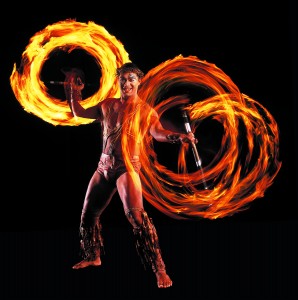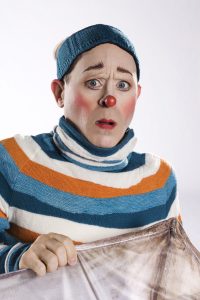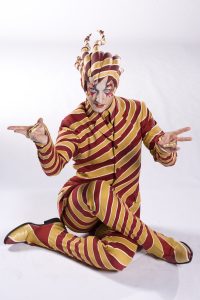
If you love acrobats and clowns, the latest incarnation of Cirque du Soleil has plenty of both.
“KOOZA,” which opens Thursday (June 3) for an extended run at the Grand Chapiteau (“big top”) at Marymoor Park in Redmond, celebrates two grand circus traditions: acrobatic performance and the art of clowning. In that sense, “KOOZA” is a return to Cirque du Soleil’s origins decades ago.
“The star of the show is the incredible acrobatics — and to a degree the clowning as well,” said “KOOZA” bandleader Seth Stachowski in a phone interview from a tour stop in Portland, Ore.
“This is a seriously acrobatic show. Whereas some Cirque shows are very, very theatrical in their design, this show is more about the ‘wow’ factor. The clowns are ridiculous and hilarious and get everyone going, but the acrobatics are just amazing. There are things that are just mind-blowing.”
“KOOZA,” one of nearly two dozen Cirque du Soleil (literally “Circus of the Sun”) productions around the world, is currently touring North America. “KOOZA” is the latest production from the Montreal-based company founded in 1984 by two former street performers.
Among the many acrobatic segments in the production are the “Hoops Manipulation,” combining contortion, balance and dexterity; and “Wheel of Death,” featuring a 1,600-pound wheel powered by two artists who “leap and counter-rotate in a death-defying display of fearless acrobatics and astonishing teamwork,” boasts a description on the Cirque du Soleil press site.

Though Stachowski wrote the music for “Hoops Manipulation,” most of the music in “KOOZA” was created by Jean-Francois Cote, a self-taught keyboardist and composer who began playing with rock and soul bands at 16.
Cote combined various musical styles and elements in the score: 1970s funk, full orchestra arrangements, Indian music, and film scores of the 1940s and ’50s.
“Pop, funk, the orchestra stuff, there’s even a little bit of big band in the production,” Stachowski said.
Stachowski leads a band of eight performers, including six musicians and two singers, all in costume. The singers are featured in the theatrical side of the production as well.
Cote created musical “building blocks” for the production, which contains many different elements.
“It was kind of constructed in a modular fashion so that the pieces could be rearranged on the fly,” Stachowski said.
“Cote would supply me with some raw materials and then we would start to work with the acts and try to figure out what their needs were and how we would need to define the music for that act — and be able to move the music around and make it kind of flow emotionally with what was happening on stage.”
The musicians and singers must remain fluid throughout each performance.
“One of the really neat things about playing these shows is that every single band member alters their performance in some way based on what is happening on stage. Whether it’s a percussionist or drummer with very specific effects or a singer changing the color of his or her voice based on what’s going on. Every single person involved in the show is making a contribution to highlight the actions on stage.”
It’s important for Stachowski to stay focused throughout an intense, action-filled production.

“There are really no dull moments in the show for me,” he said.
“I really have to be in tune with what’s going on every second. The only time when the band gets to relax is during the pickpocket act. We enjoy watching the pickpocket. It’s very fun. Otherwise, the music is pretty much nonstop.”
Aside from the acrobatics and clowning, the central theme of “KOOZA” is the story of “The Innocent,” a melancholy loner who wanders the world in search of meaning. His journey puts him in contact with an array of comical characters, among them The King, The Trickster, The Pickpocket and the Obnoxious Tourist and His Bad Dog.
Amid the slapstick humor and turmoil, “KOOZA” explores the themes of fear, personal identity, self-recognition and power.
“People in the audience figure out what the story means to them as (The Innocent) goes along his journey and is amazed by the things that he sees,” Stachowski said. “It’s definitely like Alice in Wonderland, I would say.”
Cirque du Soleil hired Stachowski, who holds a degree in music composition from the State University of New York and who has written music for film and TV, in 2006. Years before, in the early 1990s, he had been inspired by a videotape of “Novelle Experience,” Cirque du Soleil’s breakthrough production in the late ’80s and early ’90s.
“The music was kind of new at the time,” he said. “The composer was Rene Dupere, who was Cirque’s first big composer. He had a really interesting style, kind of eclectic world music, tied in with some classical influences and a little gypsy tango, and it was pretty cool in the way they put the show together — with costumes, makeup and lighting — and how it all worked together.”
“I had never seen anything quite like it before. As a new art form, it was inspiring.”
For ticket information and other details, visit the Cirque du Soleil Web site.
Read my review of Cirque du Soleil’s “Saltimbanco” in 2000.
And read a review of the very Cirque-like Teatro ZinZanni, a Seattle-based production that celebrated its tenth anniversary last fall.
